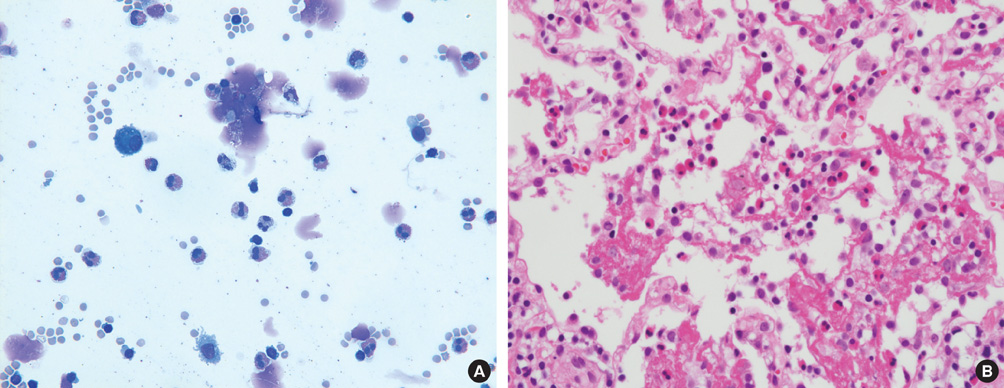Allergy Asthma Immunol Res.
2010 Apr;2(2):144-148. 10.4168/aair.2010.2.2.144.
Smoking-Induced Acute Eosinophilic Pneumonia in a 15-year-old Girl: A Case Report
- Affiliations
-
- 1Department of Pediatrics, Childhood Asthma Atopy Center, Asan Medical Center, University of Ulsan College of Medicine, Seoul, Korea. sjhong@amc.seoul.kr
- KMID: 2260602
- DOI: http://doi.org/10.4168/aair.2010.2.2.144
Abstract
- Acute eosinophilic pneumonia is a very rare disease that is characterized by acute febrile respiratory failure, diffuse bilateral infiltrates on chest X-ray, and eosinophilia in bronchoalveolar lavage fluid in the absence of infection. We present the case of a 15-year-old girl diagnosed with smoking-induced acute eosinophilic pneumonia. A previously healthy young girl with a 1-day history of fever presented with cough, dyspnea, and diffuse bilateral infiltrates on chest X-ray. She had started smoking only 3 weeks before presentation. She was diagnosed by bronchoalveolar lavage fluid tests and lung biopsy and dramatically improved after steroid treatment. We emphasize that acute eosinophilic pneumonia must be considered when acute pneumonia does not respond to broad-spectrum antibiotics. Effective treatment and prompt institution of therapy can obviate unnecessary morbidity and mortality.
MeSH Terms
Figure
Reference
-
1. Badesch DB, King TE Jr, Schwarz MI. Acute eosinophilic pneumonia: a hypersensitivity phenomenon? Am Rev Respir Dis. 1989. 139:249–252.2. Allen JN, Pacht ER, Gadek JE, Davis WB. Acute eosinophilic pneumonia as a reversible cause of noninfectious respiratory failure. N Engl J Med. 1989. 321:569–574.3. Oermann CM, Panesar KS, Langston C, Larsen GL, Menendez AA, Schofield DE, Cosio C, Fan LL. Pulmonary infiltrates with eosinophilia syndromes in children. J Pediatr. 2000. 136:351–358.4. Pope-Harman AL, Davis WB, Allen ED, Christoforidis AJ, Allen JN. Acute eosinophilic pneumonia. A summary of 15 cases and review of the literature. Medicine (Baltimore). 1996. 75:334–342.5. Cottin V, Cordier JF. Eosinophilic pneumonias. Allergy. 2005. 60:841–857.6. Son C. Eosinophilic pneumonia. Tuberc Respir Dis. 2008. 64:177–186. Korean.7. Löffler W. Zur differential-diagnose der lungeninfiltrierungen. Il uber fluchtige succedan-infiltrate (mit eosinophilie). Beitr Klin Tuberk. 1932. 79:368–392.8. Crofton JW, Livingstone JL, Oswald NC, Roberts AT. Pulmonary eosinophilia. Thorax. 1952. 7:1–35.9. Carrington CB, Addington WW, Goff AM, Madoff IM, Marks A, Schwaber JR, Gaensler EA. Chronic eosinophilic pneumonia. N Engl J Med. 1969. 280:787–798.10. Jeong YJ, Kim KI, Seo IJ, Lee CH, Lee KN, Kim KN, Kim JS, Kwon WJ. Eosinophilic lung diseases: a clinical, radiologic, and pathologic overview. Radiographics. 2007. 27:617–637. discussion 37-9.11. Rom WN, Weiden M, Garcia R, Yie TA, Vathesatogkit P, Tse DB, McGuinness G, Roggli V, Prezant D. Acute eosinophilic pneumonia in a New York City firefighter exposed to World Trade Center dust. Am J Respir Crit Care Med. 2002. 166:797–800.12. Philit F, Etienne-Mastroianni B, Parrot A, Guerin C, Robert D, Cordier JF. Idiopathic acute eosinophilic pneumonia: a study of 22 patients. Am J Respir Crit Care Med. 2002. 166:1235–1239.13. Watanabe K, Fujimura M, Kasahara K, Yasui M, Myou S, Kita T, Watanabe A, Nakao S. Acute eosinophilic pneumonia following cigarette smoking: a case report including cigarette-smoking challenge test. Intern Med. 2002. 41:1016–1020.14. Shintani H, Fujimura M, Ishiura Y, Noto M. A case of cigarette smoking-induced acute eosinophilic pneumonia showing tolerance. Chest. 2000. 117:277–279.15. Shin JH, Kwon YE, Yoon SH, Lee SI. Two cases of cigarette smoking-induced acute eosinophilic pneumonia. Korean J Asthma Allergy Clin Immunol. 2007. 27:277–282. Korean.16. Uchiyama H, Suda T, Nakamura Y, Shirai M, Gemma H, Shirai T, Toyoshima M, Imokawa S, Yasuda K, Ida M, Nakano Y, Inui N, Sato J, Hayakawa H, Chida K. Alterations in smoking habits are associated with acute eosinophilic pneumonia. Chest. 2008. 133:1174–1180.17. Shorr AF, Scoville SL, Cersovsky SB, Shanks GD, Ockenhouse CF, Smoak BL, Carr WW, Petruccelli BP. Acute eosinophilic pneumonia among US Military personnel deployed in or near Iraq. JAMA. 2004. 292:2997–3005.18. Yong SJ. Diagnosis of eosinophilic lung disease. Tuberc Respir Dis. 2008. 64:75–79. Korean.19. Allen J. Acute eosinophilic pneumonia. Semin Respir Crit Care Med. 2006. 27:142–147.20. King MA, Pope-Harman AL, Allen JN, Christoforidis GA, Christoforidis AJ. Acute eosinophilic pneumonia: radiologic and clinical features. Radiology. 1997. 203:715–719.21. Daimon T, Johkoh T, Sumikawa H, Honda O, Fujimoto K, Koga T, Arakawa H, Yanagawa M, Inoue A, Mihara N, Tomiyama N, Nakamura H, Sugiyama Y. Acute eosinophilic pneumonia: Thin-section CT findings in 29 patients. Eur J Radiol. 2008. 65:462–467.22. Korea Center for Disease Control and Prevention (KCDC). Results of Korea youth risk behavior web-based survey (KYRBWS). 2006. Available from: http://healthy1318.cdc.go.kr/.23. Park SW, Kim JY. Validity of self-reported smoking using urinary cotinine among vocational high school students. J Prev Med Public Health. 2009. 42:223–230.24. Hayakawa H, Sato A, Toyoshima M, Imokawa S, Taniguchi M. A clinical study of idiopathic eosinophilic pneumonia. Chest. 1994. 105:1462–1466.25. Jantz MA, Sahn SA. Corticosteroids in acute respiratory failure. Am J Respir Crit Care Med. 1999. 160:1079–1100.26. Buchheit J, Eid N, Rodgers G Jr, Feger T, Yakoub O. Acute eosinophilic pneumonia with respiratory failure: a new syndrome? Am Rev Respir Dis. 1992. 145:716–718.
- Full Text Links
- Actions
-
Cited
- CITED
-
- Close
- Share
- Similar articles
-
- New Onset Cigarette Smoking-Induced Acute Eosinophilic Pneumonia: Case Report and Review of the Literature
- Cigarette Smoking-Induced Acute Eosinophilic Pneumonia: A Case Report Including a Provocation Test
- A Case of Smoking Induced Acute Eosinophilic Pneumonia
- A Case of Acute Eosinophilic Pneumonia Following Cigarette Smoking
- Acute eosinophilic pneumonia caused by passive smoking




